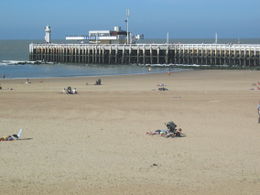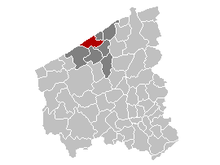Ostend
|
|||||||||||||||||||||||||||||||||||||||||||||||||
.jpg)
St Petrus and St Paulus Church
|
|||||||||||||||||||||||||||||||||||||||||||||||||

Beach, seafront and Europacenter building
|
|||||||||||||||||||||||||||||||||||||||||||||||||
Ostend (Dutch: Oostende, Dutch pronunciation: [oˑstˈɛndə]) is a Belgian city and municipality located in the Flemish province of West Flanders. It comprises the boroughs of Mariakerke, Stene and Zandvoorde, and the city of Ostend proper – the largest on the Belgian coast.
Contents |
History
Origin to Middle Ages
In earlier times, Ostend was nothing more than a small village built on the east-end (Dutch: oost-einde) of an island (originally called Testerep) between the North Sea and a beach lake. Although small, the village rose to the status of "city" around 1265 when the inhabitants were allowed to hold a market and to build a market hall.
The major source of income for the inhabitants was fishing. The North Sea coastline has always been rather unstable and in 1395 the inhabitants decided to build a new Ostend behind large dikes and further away from the always-threatening sea.
15th to 18th century

The strategic position on the North Sea coast had major advantages for Ostend as a harbour but also proved to be a source of trouble. The city was frequently taken, ravaged, ransacked and destroyed by conquering armies. The most important of these events was the three-year Siege of Ostend between 1601 and 1604, with on both sides combined more than 80,000 dead or wounded. In their fight against the Spanish Empire during the Eighty Years' War, the Dutch rebels, the Geuzen, had occupied the city.
After this era Ostend turned into a harbour of some importance. In 1722 the Dutch again closed off the entrance to the harbour of Antwerp, the Westerschelde. Therefore, Ostend rose in importance because the city provided an alternative exit to the sea. The Southern Netherlands (largely the territory of present Belgium) had become part of the Austrian Empire. The Austrian Emperor Charles VI granted the city the trade monopoly with Africa and the Far-East. The Oostendse Compagnie (the "Ostend trade company") was allowed to found colonies overseas. However, in 1727 the Oostendse Compagnie was forced to stop its activities because of Dutch and British pressure. The Netherlands and Britain would not allow competitors on the international trade level. Both nations regarded international trade as their privilege.
Modern era
In later times the harbour of Ostend continued to expand because the harbour dock, as well as the traffic connections with the hinterland, were improved. In 1838 a railway connection with Brussels was constructed. Ostend became a transit harbour to England in 1846 when the first ferry sailed to Dover. The city hosted some of the sailing events for the 1920 Summer Olympics in neighboring Antwerp. It no longer serves in that role today, except for freight, as an alternative channel crossing point to Calais, France. Very important for the image of the city was the attention it started to receive from the Belgian kings Leopold I and Leopold II. Both liked to spend their vacations in Ostend. Important monuments and villas were built to please the Royal Family. The rest of aristocratic Belgium followed and soon Ostend became known as "The Queen of the Belgian sea-side resorts".
Sights
- Interesting locations are the Casino and Fort Napoleon.
- Ostend is also famous for its sea-side esplanade, pier, and fine-sand beaches.
- The James Ensor museum can be visited in the house where the artist lived from 1917 until 1949.
- The Mercator, an educational tall ship of the Belgian merchant fleet, has been converted into a maritime museum.
- Hippodrome Wellington, horse racing venue
- St Petrus and St Paulus Church, Ostend (Sint-Petrus-en-Pauluskerk), built in Neo Gothic style.
- In the Mu.Zee (a new museum after the fusion of the Provinciaal Museum voor de Moderne Kunst-Aan-Zee and the "Museum voor Schone Kunsten"), the museum of modern art from the 1830s to the present, you can view works of noted local painters such as James Ensor, Leon Spilliaert, Constant Permeke and the revolutionary post-war Belgian COBRA movement amongst others.
- Beach(es): Ostend is visited by many 'day' tourists, especially during July and August. Tourists from the Belgian inland and foreigners mostly arrive by train (day trips) and head for the closest beach area from the station (kleinstrand). The locals and other residents in Belgium usually occupy the larger beach (grootstrand). Ostend is widely visited by British, Germans, French and Dutch. Buses from Brussels tend to pass through giving the opportunity to North American and Asian tourists to view Ostend.
- Near the beach is a well-preserved section of the World War II Atlantic Wall.
- Views from the pier promenade or beach of departing and arriving passenger ferry ships from Ramsgate (UK).
- During summer evenings (or just any kind of weather) you can walk through the little streets around Het Vissersplein. At certain times there are local markets in the neighbourhood streets and in the summer the Vissersplein has music festivals. The Vissersplein (Bonenstraat/Kadzandstraat) is a car free zone with many brasseries where you can sit outside and have a drink. Look towards the port side and find many little fish outlets, and beyond that, again, you can view close the ferries docking.
- Train station
- Film locations: more and more directors are filming in Ostend.
The movies Place Vendôme with Catherine Deneuve; Daughters of Darkness [1] with Delphine Seyrig as Countess Bathory; Armaguedon [2] with Alain Delon; Camping Cosmos with Lolo Ferrari; and Ex-Drummer based on the novel by Herman Brusselmans were partially shot in Ostend. - The comic Le Bal du rat mort [3] about a dreadful invasion of rats, is set in Ostend.

Economy
Jetairfly has its headquarters in Ostend.[4] TAAG Angola Airlines's Ostend offices are on the grounds of Ostend Airport in Ostend.[5]
Gallery
 Flower Clock |
Municipal park. |
.jpg) In front of the railway station: The waiting fisherman's wives, bronze (1998) by August Michiels (1922-2003). |
 The Peperbusse - local name for an old church tower from a burned down church. |
|
Spanish Inn 1729 (Kapucijnenstraat). |
 The esplanade with the Thermae Palace Hotel, the former royal residence and the casino |
 Ostend and the museumship, the barquentine Mercator. |
.jpg) Traditional fishers' dress - early 20th century. |
Notable citizens of Ostend
References to these notable citizens of Ostend can be found here : Oostendse biografieën (in Dutch)
- Lilian Baels, princess
- Auguste Marie Francois Beernaert, Prime Minister of Belgium and Nobel Peace Prize recipient
- Alfred Belpaire, locomotive engineer
- Gerard Brackx, tourism
- Cesar De Paepe, syndicalist
- James Ensor, painter
- Etienne Elias, painter
- Marvin Gaye, singer
- Hubert Minnebo, sculptor
- Arno Hintjens, lead-singer of TC Matic
- Karel Jonckheere, writer
- Mimi Lamote (b. Ostend, 27 April 1964), businesswoman
- Stefaan Maene, backstroke swimmer
- Marie-José of Belgium, princess, then last queen of Italy
- August Michiels, sculpturer, painter, engraver
- Constant Permeke, expressionist painter
- Raoul Servais, filmmaker
- Gustaaf Sorel, painter
- Leon Spilliaert, painter
- Henri Storck, author, film-maker, and maker of documentaries
- Robert Triffin, economist
- Johan Vande Lanotte, politician
- Robert Van De Walle, judoka
- Bart van den Bossche, singer, actor, and radio/TV presenter
- Peter Van Heirseele, aka Herr Seele, cartoonist (Cowboy Henk), painter and performer
- Rudolf Vanmoerkerke
Sport clubs
- Hermes Volley Oostende (volleyball)
- K.V. Oostende (football)
- Telindus Oostende (basketball)
- Wellington Golf Oostende (Golf)
See also
- Greenbridge science park
- Ostend Manifesto
- Olvoband
External links
- Official website - Information available in Dutch and limited information available in French, English and German.
- Oostendse verhalen- Site about the Ostend dialect and culture with Ostend grammatical rules. (mainly in Dutch (nl) and Ostend dialect).
- Toerisme Oostende - English edition - extensive.
- Free photos of Ostend
- Ostend Airport - Official website of the international airport of Ostend.
- Ostend photo gallery
- Official website Port of Oostende
References
- ↑ Daughters of Darkness at IMDB
- ↑ Armaguedon at IMDB
- ↑ Le Bal du rat mort
- ↑ "TUIfly Academy Brussels." Jetairfly. Retrieved on 23 October 2009.
- ↑ "TAAG Offices." TAAG Angola Airlines. Retrieved on 23 January 2010.
|
|||||
|
||||||||||||||||||||||||||||
|
|||||





